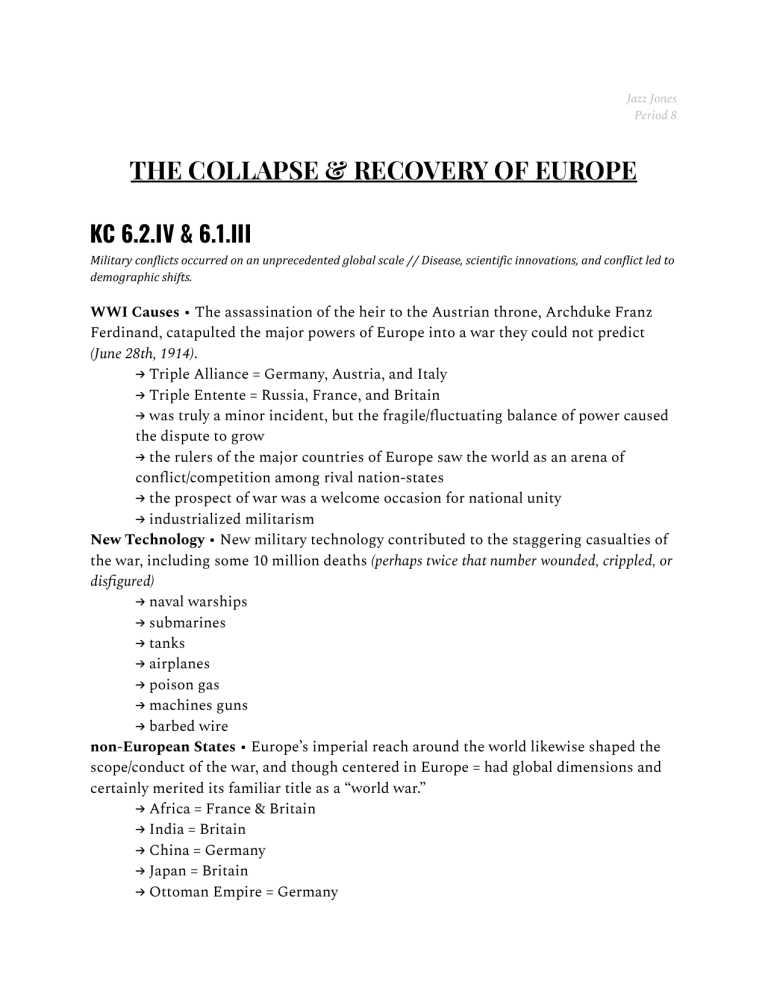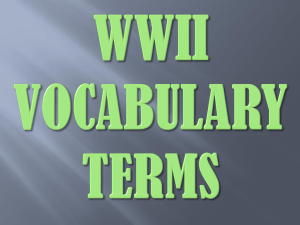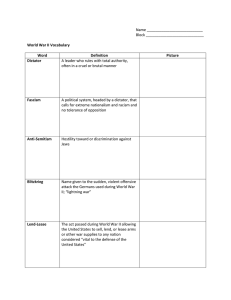
Jazz Jones Period 8 THE COLLAPSE & RECOVERY OF EUROPE KC 6.2.IV & 6.1.III Military conflicts occurred on an unprecedented global scale // Disease, scientific innovations, and conflict led to demographic shifts. WWI Causes • The assassination of the heir to the Austrian throne, Archduke Franz Ferdinand, catapulted the major powers of Europe into a war they could not predict (June 28th, 1914). → Triple Alliance = Germany, Austria, and Italy → Triple Entente = Russia, France, and Britain → was truly a minor incident, but the fragile/fluctuating balance of power caused the dispute to grow → the rulers of the major countries of Europe saw the world as an arena of conflict/competition among rival nation-states → the prospect of war was a welcome occasion for national unity → industrialized militarism New Technology • New military technology contributed to the staggering casualties of the war, including some 10 million deaths (perhaps twice that number wounded, crippled, or disfigured) → naval warships → submarines → tanks → airplanes → poison gas → machines guns → barbed wire non-European States • Europe’s imperial reach around the world likewise shaped the scope/conduct of the war, and though centered in Europe = had global dimensions and certainly merited its familiar title as a “world war.” → Africa = France & Britain → India = Britain → China = Germany → Japan = Britain → Ottoman Empire = Germany → Australia = Britain → New Zealand = Britain → Canada = France → South Africa = Britain → United States = joined when Germany threatened them (1917) KC 6.2.IV, 6.1.III & 6.2.I Military conflicts occurred on an unprecedented global scale // c // Europe dominated the global political order at the beginning of the 20th century, but both land-based and transoceanic empires gave way to new states by the century’s end. The Loss of Life • The destructive potential of industrialized warfare made itself tragically felt and the new trench warfare resulted in enormous casualties. Women • Most women on both sides actively supported their countries’ war efforts →in factories = women replaced the men who had le for the battlefront → caused a halt to the women’s suffrage movement & to women’s activities on behalf of international peace National Self-Determination • Creation of national governmental institutions by a group of people who view themselves as a distinct nation → coined by Woodrow Wilson (U.S. President) → opposed to colonialism and imperialism → brought the emergence of a new Central Europe (Poland, Czechoslovakia, Yugoslavia, etc.) The Armenian Genocide • During the war itself, Ottoman authorities massacred or deported an estimated 1 million Armenians. → suspected that some of their Armenian population were collaborating w/the Russian enemy Impacts on the Ottoman Empire • Brought a final end to a declining Ottoman Empire, creating the modern map of the Middle East → new states = Turkey, Syria, Iraq, Jordan, and Palestine → Arabs emerged from Turkish rule → conflicting British promises to both Arabs and Jews regarding Palestine set the stage for an enduring struggle over that ancient and holy land Impacts on India • To gain Indian support for the war, the British had publicly promised to put that colony on the road to self-government → set the stage for the independence struggle that followed Impacts on Japan • Emerged strengthened from the war, w/European support for its claim to take over German territory and privileges in China (enraged Chinese nationalists) KC 6.3.I States responded in a variety of ways to the economic challenges of the 20th century. The Great Depression • All across the Euro-American heartland of the capitalist world, this vaunted economic system seemed to unravel (started in 1929). → never had the flaws of capitalism been so evident or so devastating → if World War I = political collapse of Europe, the depression = economic system collapse → the day the American stock market initially crashed = October 24, 1929 → the main fear was the lost of work (unemployment soared everywhere) Effects • Depending on a single crop or product rendered these societies extraordinarily vulnerable to changes in the world market. → Chile = dependent on copper mining, found the value of its exports cut by 80 percent → Brazil = destroyed enough of its coffee crop to have supplied the world for a year in an effort to maintain the price of coffee → SE Asia = (the world’s major rubber-producing region) saw the demand for its primary export drop dramatically as automobile sales in Europe/United States were cut in ½. → the Gold Coast in Africa = farmers who had staked their economic lives (on producing cocoa) for the world market were badly hurt by the collapse of commodity prices Franklin Roosevelt’s Response • The New Deal was an experimental combination of reforms seeking to restart economic growth and to prevent similar calamities in the future → permanently altered the relationship among government, the private economy, and individual citizens → attempted to create a modest economic safety net to sustain the poor, the unemployed, and the elderly → supporting labor unions → ultimately = none of the New Deal’s programs worked very well to end the Great Depression KC 6.2.IV & 6.1.III Military conflicts occurred on an unprecedented global scale // Military conflicts occurred on an unprecedented global scale Fascism • Intensely nationalistic, seeked to revitalize and purify the nation & to mobilize its people for some grand task. Praised violence against enemies as a renewing force in society, celebrated action rather than reflection, and placed their faith in a charismatic leader. → condemned individualism, liberalism, feminism, parliamentary democracy, & communism (they argued the these divided/weakened the nation) → authoritarian political ideology → Italy = the first to be fascist (led by Benito Mussolini) → Germany = led by Adolf Hitler → Japan → small movements = France, Great Britain, and the Netherlands → substantial movements = Austria, Hungary, Romania, and Spain (had a civil war) Negative Impacting on Jews • In Hitler’s thinking & in Nazi propaganda, Jews became the symbol of the urban, capitalist, and foreign influences that were undermining traditional German culture. → the Nazis reflected/reinforced a broader & long-established current of anti-Semitism → the Nuremberg Laws = ended German citizenship for Jews and forbade marriage/sexual relations between Jews & Germans → November 9, 1938 = persecution gave way to terror, when Nazis smashed/looted Jewish shops (known as Kristallnacht) → the mass killing of Europe’s Jews emerged only in the context of World War II Changes in Japan (1920s to 1930s) • Japan also moved toward authoritarian government and a denial of democracy at home, even as it launched an aggressive program of territorial expansion in East Asia. →the 1920s = seemed to be moving toward a more democratic politics & Western cultural values → the impact of the Great Depression = harsher and more authoritarian action (the worldwide economic catastrophe hit Japan hard) → many began to doubt the ability of parliamentary democracy and capitalism to address Japan’s “national emergency” → Radical Nationalism (the Revolutionary Right) = an extreme nationalism, hostility to parliamentary democracy, a commitment to elite leadership focused around an exalted emperor, and dedication to foreign expansion → although shared some common features with fascist Italy & Nazi Germany, it remained (internally) a less repressive and more pluralistic society than either of those European states Japanese Aggression • Japanese imperial ambitions mounted as the military became more powerful in Japan’s political life and as an earlier cultural cosmopolitanism gave way to more nationalist sentiments. → establishment of Manchukuo (Manchuria in 1931) = infuriated Western powers, prompting Japan to withdraw from the League of Nations, to break politically with its Western allies, and in to align more closely with Germany and Italy (1936) → the view of the world held by Japanese authorities and many ordinary people hardened = they felt isolated, surrounded, and threatened (their national survival was at stake) → in 1940–1941, the Japanese presented themselves as liberators/modernizers, creating an “Asia for Asians” and freeing their continent from European dominance = soon showed that Japan’s concern was far more for Asia’s resources than for its liberation & that Japanese rule exceeded in brutality even that of the Europeans → a decisive step in the development of World War II in Asia = the Japanese attack on the United States at Pearl Harbor (December 1941) German Aggression • WWII was more deliberate and planned, perhaps even desired by the German leadership and by Hitler in particular → war was central to the Nazi phenomenon in several ways: nazism was born out of WWI, the hated treaty that ended it, the disillusioned ex-soldiers who emerged from it, and the celebration of war as a means of ennobling humanity and enabling the rise of superior peoples was at the core of Nazi ideology → slowly at first and then more aggressively, Hitler prepared the country for war and pursued territorial expansion (major rearmament program began in 1935) → in 1939, Germany unleashed a devastating attack on Poland (an action that triggered the Second World War in Europe) = Britain and France declared war on Germany New Technology • The most destructive conflict in world history because of the new technologies of warfare → the German tactic of blitzkrieg (lightning war) = coordinated the rapid movement of infantry, tanks, and airpower over very large areas. → heavy bombers → jet fighters → missiles → atomic weapons Women • War heightened the prestige of masculinity, and given the immense sacrifices that men had made, few women were inclined to directly challenge the practices of patriarchy immediately following the war. → “comfort woman” = several hundred thousand women from Korea, China, and elsewhere to serve the sexual needs of Japanese troops (who o en accommodated twenty to thirty men a day) → US = the needs of the war drew large numbers of women into both industry and the military (a temporary necessity) → “Rosie the Riveter” represented women who now took on heavy industrial jobs, which previously had been reserved for men → USSR = women constituted more than half of the workforce by 1945 Holocaust • A “final solution” to the Jewish question: emerged the death camps that included Auschwitz, Dachau, and Bergen-Belsen → Millions more whom the Nazis deemed inferior, undesirable, or dangerous (Russians, Poles, other Slavs; Gypsies; mentally/physically handicapped people; homosexuals; communists; Jehovah’s Witnesses) likewise perished in Germany’s efforts at racial purification → sent many of Europe’s remaining Jews fleeing to Israel & gave urgency to the establishment of a modern Jewish nation in the ancient Jewish homeland = outraged many Arabs & has fostered an enduring conflict in the Middle East → defined a new category of crimes against humanity: genocide (the attempted elimination of entire peoples) New Era Nationalism • Not only had the war weakened both the will and the ability of European powers to hold onto their colonies, but it had also emboldened nationalist & anticolonial movements everywhere. KC 6.3.II States, communities, and individuals became increasingly interdependent—a process facilitated by the growth of institutions of global governance. United Nations (UN) • A political body dependent on agreement among its most powerful members, the UN proved more effective as a forum for international opinion than as a means of resolving the major conflicts of the postwar world. The World Bank & the International Monetary Fund (IMF) • Purpose was to regulate the global economy, prevent another depression, and stimulate economic growth, especially in the poorer nations. The Marshall Plan • An early indication of the United States’ intention to exercise global leadership took shape in its efforts to rebuild/reshape shattered European econ. = funneled into Europe some $12 billion, at the time a very large amount, together w/numerous advisers and technicians → motivated by some combination of genuine humanitarian concern, a desire to prevent a new depression by creating overseas customers for American industrial goods, and an interest in undermining the growing appeal of European communist parties The European Coal and Steel Community (ECSC) • Italy, France,West Germany, Belgium, the Netherlands, and Luxembourg came together to jointly manage the production of critical items → a er decades of conflict and destruction almost beyond description, many Europeans were eager to cooperate with one another European Economic Community (EEC) • Whose members reduced their tariffs and developed common trade policies (more widely known as the Common Market). → expanded its membership to include almost all of Europe, including many former communist states → all of this sustained Europe’s remarkable economic recovery & expressed a larger European identity, although it certainly did not erase deeply rooted national loyalties. European Union (EU) • In 1994, the EEC was renamed the European Union. → in 2002, twelve of its members adopted a common currency: the euro → didn’t it lead to a political union (a United States of Europe) North Atlantic Treaty Organization (NATO) • Committed the United States and its nuclear arsenal to the defense of Europe against the Soviet Union, and it firmly anchored West Germany within the Western alliance.



